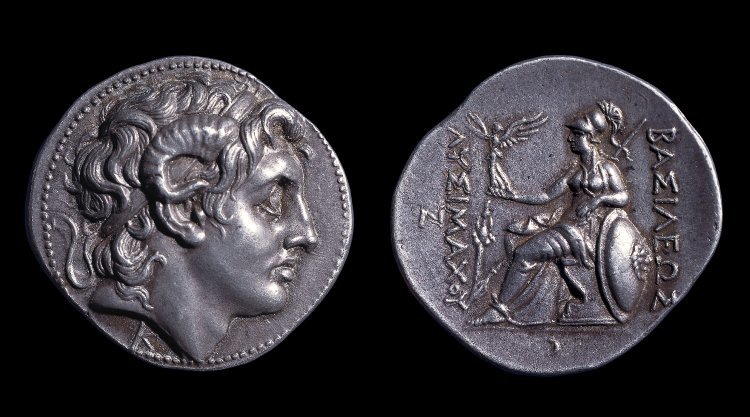Coin of Lysimachos
Title
Coin of Lysimachos
Date
305-281 BC
Artist or Workshop
State of the Kingdom of Thrace
Materials
Silver
Height of the work
ca. 3 cm diameter
Provenience
Minted in Lampsacus, (Asia,Turkey,Mysia,Lâpseki,Lampsacus)
Current Location
The British Museum, London, England
Sitter Biography
A former general and companion of Alexander, Lysimachus (reigned 305-281 BC) inherited the kingdom of Thrace in Northern Greece, to which he subsequently added parts of Asia Minor (modern Turkey).
Description and Significance
Description:
The obverse of this silver coin shows the head of Alexander the Great. His head is shown facing the right, diademed and wearing a ram's horn. Alexander is shown youthful and clean-shaven, as he preferred to be portrayed. He is shown with long locks of hair rising above his forehead with eyes cast upwards.
The reverse of the coin portrays the goddess Athena and Nike crowning a name with laurels. This side portrays a seated Athena, the goddess of war, a spear and shield beside her, holding Nike in her outstretched arm. Athena's shield is shown with a lion. The reverse also features a Greek legend which translates 'Of King Lysimachus'.
Significance:
Alexander's portrait was featured on many coins circulating in the kingdom. Alexander's image stood for an established and dependable empire. The successors of Alexander used his portrait to portray similar beliefs. Lysimachus used the king’s image on his own coins in order to cast himself in the role of successor and legitimize his claim to the kingdom of Thrace.
The ram horns that are shown on Alexander's head are "horns of Ammon" symbolizing Alexander's claim that he was the son of Egyptian god Ammon. By alluding to his divine parenthood, he is capitalizing on the Egyptian Tradition in which pharaohs were thought to be gods on Earth.
On the reverse, Athena and Nike (Victory) are shown crowning Lysimachus name with laurels, symbolizing victory and honor. This exerts his own royal authority by naming himself "king". Athena is holding a shield to her side with a lion. The lion references Lysimachus's famous exploit of killing a lion with his bare hands and reinforces his association with Alexander, who used the skin of the Nemean lion as a symbol of courage and power. The inscription, translated from Greek, reads "OF KING LYSIMACHUS."
The obverse of this silver coin shows the head of Alexander the Great. His head is shown facing the right, diademed and wearing a ram's horn. Alexander is shown youthful and clean-shaven, as he preferred to be portrayed. He is shown with long locks of hair rising above his forehead with eyes cast upwards.
The reverse of the coin portrays the goddess Athena and Nike crowning a name with laurels. This side portrays a seated Athena, the goddess of war, a spear and shield beside her, holding Nike in her outstretched arm. Athena's shield is shown with a lion. The reverse also features a Greek legend which translates 'Of King Lysimachus'.
Significance:
Alexander's portrait was featured on many coins circulating in the kingdom. Alexander's image stood for an established and dependable empire. The successors of Alexander used his portrait to portray similar beliefs. Lysimachus used the king’s image on his own coins in order to cast himself in the role of successor and legitimize his claim to the kingdom of Thrace.
The ram horns that are shown on Alexander's head are "horns of Ammon" symbolizing Alexander's claim that he was the son of Egyptian god Ammon. By alluding to his divine parenthood, he is capitalizing on the Egyptian Tradition in which pharaohs were thought to be gods on Earth.
On the reverse, Athena and Nike (Victory) are shown crowning Lysimachus name with laurels, symbolizing victory and honor. This exerts his own royal authority by naming himself "king". Athena is holding a shield to her side with a lion. The lion references Lysimachus's famous exploit of killing a lion with his bare hands and reinforces his association with Alexander, who used the skin of the Nemean lion as a symbol of courage and power. The inscription, translated from Greek, reads "OF KING LYSIMACHUS."
References
Petac, Emanuel. “From the Types of Alexander to Lysimachus: The Chronology of Some Mesembrian and Other West Pontic Staters.” American Journal of Numismatics (1989-), vol. 23, 2011, pp. 7–15. JSTOR, JSTOR, www.jstor.org/stable/43619972.
http://www.jstor.org.proxy-um.researchport.umd.edu/stable/pdf/43619972.pdf?refreqid=search%3Ae9a32e3a56c13a57487fafdbe3e5f963
“Collection Online.” Britishmuseum.org, The British Museum , www.britishmuseum.org/research/collection_online/collection_object_details.aspx?objectId=1264038&partId=1.
http://www.jstor.org.proxy-um.researchport.umd.edu/stable/pdf/43619972.pdf?refreqid=search%3Ae9a32e3a56c13a57487fafdbe3e5f963
“Collection Online.” Britishmuseum.org, The British Museum , www.britishmuseum.org/research/collection_online/collection_object_details.aspx?objectId=1264038&partId=1.
Contributor
Anna Nielsen
Citation
State of the Kingdom of Thrace, “Coin of Lysimachos,” Digital Portrait "Basket" - ARTH488A - "Ancient Mediterranean Portraiture", accessed May 20, 2024, https://classicalchopped2.artinterp.org/omeka/items/show/24.
Item Relations
This item has no relations.

